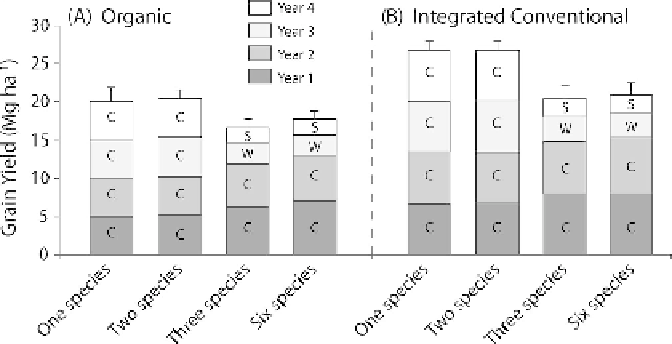Agriculture Reference
In-Depth Information
produced and its market price are important, but the foundation to generating profit
is sufficient production, and crop species vary in their ability to deliver this. Corn
provides a biological advantage over other major grain crops such as soybean and
wheat because of its greater efficiency at transforming sunlight into grain. This is
shown by a broad-stroke comparison of LFL grain yields on a whole system basis.
Figure 15.2 shows that a continuous corn rotation produced 5.7 Mg ha
−1
yr
−1
of
grain, on average, over 4 years, whereas over the same period a corn-corn-soybean
rotation produced 4.6 Mg ha
−1
yr
−1
(means for Organic and Integrated Conventional
systems). Cumulative grain production over this period was 20.2 Mg ha
−1
in the
Organic one-species system (continuous corn), 17.1 Mg ha
−1
in the Organic three-
species (rotation crop sequence), 25.7 Mg ha
−1
in the Integrated Conventional
one-species system, and 19.7 Mg ha
−1
in the Integrated Conventional three-species
system.
On a whole system basis, the low-diversity continuous corn system produced
the most grain. However, a higher market price for soybean and wheat will in many
cases compensate for the moderate yield potential of rotated crops compared to
corn. This will be especially true in locales without high corn subsides.
Nevertheless, LFL crop diversity enhanced corn grain yield: corn in rotation
was almost always associated with higher yields compared to continuous corn
(Fig. 15.2). Although diversity imparted via cover crops was not associated with
higher corn grain yield in the Integrated Conventional system, a positive trend was
observed in the rotated Organic system. No biodiversity effect of cover crops was
Figure 15.2
. Grain yields in the various diversity treatments of the Living Field Lab (means
and standard deviations for four replicate plots). A) Annual grain yield average in a four-
year rotation sequence under Organic management at the Living Field Lab, where C=corn,
W=wheat and S=soybean. The cropping systems include one species (continuous C), two-
species (continuous C with a winter annual cover crop), three species (rotated C-C-S-W),
and six species (C-C-S-W with winter cover crops red clover, annual ryegrass and crimson
clover). B) Annual grain yield average under Integrated Conventional management; crop-
ping systems as described for Organic.

